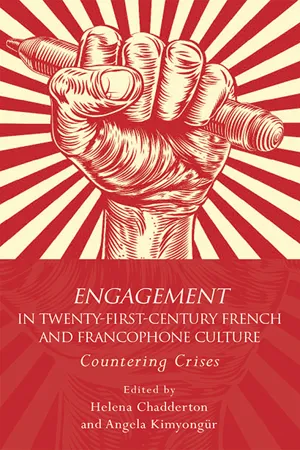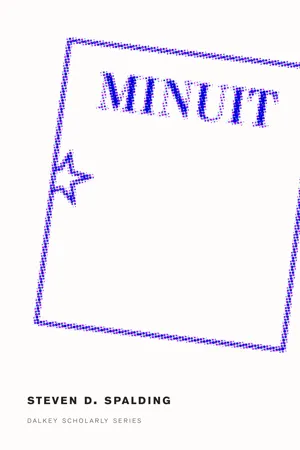Literature
Nouveau Roman
Nouveau Roman is a French literary movement that emerged in the 1950s. It is characterized by a focus on form over content, experimentation with narrative techniques, and a rejection of traditional plot structures and character development. The movement aimed to challenge conventional storytelling and create a new kind of literature.
Written by Perlego with AI-assistance
4 Key excerpts on "Nouveau Roman"
- eBook - ePub
The Narrative Turn in Fiction and Theory
The Crisis and Return of Storytelling from Robbe-Grillet to Tournier
- H. Meretoja(Author)
- 2014(Publication Date)
- Palgrave Macmillan(Publisher)
all narrative fiction that the act of narration creates the story and the existence of the latter depends on the former?This does not mean that this or any other novel totally dispenses with narrativity – and it is doubtful whether that would be possible in any case. The nouveaux romans typically play with storytelling and thematize the ontological instability that undermines their narrativity, as in this passage:Simon did not know whether he should grant them the status of recollections, as though they were events of his real life; or else whether they were not, instead, images such as are shaped in dreams[.] (M&D: 74–5)Simon ne savait pas s’il fallait qu’il leur accordât le statut de souvenirs, comme à des événements de sa vie réelle; ou bien s’il ne s’agissait pas plutôt des ces figures formées dans les rêves[.] (D: 85)Nevertheless, such novels contain narrative fragments and sketch a fractured, disjointed fictive world, no matter how incoherent and ontologically unstable. As Robbe-Grillet himself notes, what is decisive is not the total abandonment of the story, but that it has lost ‘its certainty, its tranquillity, its innocence’ (FNN: 33). In his later novels, and in other nouveaux romans in the 1960s and 1970s, the antirepresentational dimension is further radicalized, for example by the increasing discontinuity and mutual contradictions of their ‘textual spaces’.9 These spaces are never totally discontinuous, but neither do they settle into a linear, coherent story.The nouveaux romans typically leave unanswered the basic questions raised by the initial setting. In Dans le labyrinthe , these questions include: Who is the soldier? Why does he strive to meet the person for whom he is searching? When and where does the story take place? As the narration proceeds, it becomes clear that the point of the narrative is not to answer such questions but, rather, to make visible expectations that are normally taken for granted in reading narratives and, by thwarting these expectations, to draw the reader’s attention to the how of the narration and to the very impulse to narrativize: to our almost instinctive tendency to weave disconnected elements into narratives, constructing, from narrative fragments, characters and storyworlds and assuming that the narration is necessarily about a person’s experiences in a stable world. It thereby contests and makes visible some of our basic assumptions concerning what narrative fiction is about. By rendering uncertain not only what has happened but also who is telling what to whom and in what world, it undermines the commonly held assumption that narrative fiction necessarily represents someone’s consciousness and that it inevitably communicates something to the reader. As it makes both the subject of experience and the (story)world waver, the Nouveau Roman - eBook - ePub
Nathalie Sarraute
A Life Between
- Ann Jefferson(Author)
- 2020(Publication Date)
- Princeton University Press(Publisher)
On Her Own Terms, 1970–99
Passage contains an image
CHAPTER THIRTY
The End and Afterlife of the Nouveau Roman, 1971–82
IN JULY 1971 , the Nouveau Roman was once again given collective visibility in the form of a décade at the Château de Cerisy-la-Salle, in the rural surrounds of Lower Normandy. The château regularly hosted conferences run by the daughter and granddaughters of Paul Desjardins, founder of the prewar Pontigny décades . For the event devoted to Le Nouveau Roman: hier, aujourd’hui , the organisers assembled five of the seven novelists who appeared on the famous photo of the Nouveau Roman: Robbe-Grillet, Claude Simon, Claude Ollier, Robert Pinget, and Nathalie. A sixth participant, Michel Butor (who had in any case arrived late for the 1959 photo), was unable to attend in person, but he sent a contribution to be read by a stand-in, and was present in spirit. The seventh was Jean Ricardou, one of the conference organisers, and the representative of a new generation of Nouveaux Romanciers. The event was a very different affair from the colloque at the Château d’Eu, fifteen years earlier. The austere seventeenth-century protestant château outside the village of Cerisy-la-Salle is considerably less grandiose than the Château d’Eu, and its surrounds are rustic rather than formal. More significantly, the Nouveau Roman had long since acquired a name, a reputation, and a number of established representatives.It had also acquired a certain theoretical orthodoxy, with which, increasingly, Nathalie did not concur. Whereas Butor had stopped writing novels altogether, Robbe-Grillet had formalised his approach in 1963 with the publication of his critical essays as a single volume under a title—For a New Novel —which had the unmistakeable ring of a manifesto. In the early 1960s, the Nouveau Roman was supported by the avant-garde journal Tel Quel , founded by the young novelist and critic Philippe Sollers. Nathalie was initially drawn to the journal’s ambitions and activities, which were launched in 1960 with a powerfully anti-Sartrean “Declaration.” This statement of intent rejected all theories based on ideological content in favour of allowing literature to “be concerned just with itself, its own fate and its particular rules.”1 These words would have been music to Nathalie’s ears, and she had every reason to take an interest in an enterprise whose editor—Sollers—was close to Francis Ponge, and whose first number included Virginia Woolf’s essay “The Moment” as well as two of Ponge’s own prose poems. Nathalie herself was present in the form of her contribution in answer to the question, “Do you think you have literary talent?,” and The Planetarium was among the twelve recent publications to which members of the editorial committee gave marks out of twenty. Despite the editors’ comment that the results illustrated the arbitrariness of all critical judgement, it’s nonetheless telling that only Robbe-Grillet’s In the Labyrinth and Maurice Blanchot’s volume of essays The Book to Come - eBook - ePub
Engagement in 21st Century French and Francophone Culture
Countering Crises
- Helena Chadderton, Angela Kimyongür(Authors)
- 2017(Publication Date)
- University of Wales Press(Publisher)
Part 1Culture in Crisis? Evolving Cultural Forms in the Twenty-first CenturyPassage contains an image
1Engagement in la fiction d’affaires: François Bon and Thierry BeinstingelHELENA CHADDERTONThe treatment of social and political issues and formal experimentation have been traditionally polarised in the development of the French novel. Reflecting this polarisation, from the end of the 1980s, there has been a backlash against what is perceived to be the hegemony of formalism: against self-reflexivity and metatextual questioning, which arguably came to dominate the offerings of the French novel from the Nouveau Roman onwards. Indeed, there has been a revival of narrative which is socially and historically anchored to reality. This has involved a ‘retour au récit’, or return to the story, as summarised by Simon Kemp in French Fiction into the Twenty-first Century: The Return to the Story, as well as a renewed interest in history, and a preoccupation with contemporary social and political issues.1 It is this final aspect of this revival which will interest us here. In March 2007, a campaign entitled ‘Pour une littérature-monde en français’ was launched in Le Monde to reinstate ‘le monde, le sujet, le sens, l’histoire, le “référent”’ in French literature.2 In the same way, Tzvetan Todorov, in his 2007 critique, La littérature en péril, laments what he perceives to be the metafictional posturing of French literature and calls for a return to the study of texts in terms of what they bring to ‘la connaissance de l’humain’.3 The quandary which contemporary writers now face is how to present the social and political world while nonetheless acknowledging the loss of innocence, the expected questioning of the relationship between language and the world, that has been brought about by literary theory and recent literary movements, from Barthes’s ‘death of the author’ to the Nouveau Roman’s rejection of realism on the grounds that it is the creation of an illusion. Indeed, shortly after the peak of publications associated with the Nouveau Roman, Barthes asked: ‘Notre littérature serait-elle toujours condamnée à ce va-et-vient entre le réalisme politique et l’art-pour-l’art, entre une morale de l’engagement et un purisme esthétique, entre la compromission et l’asepsie?’4 - eBook - ePub
- Steve Spalding(Author)
- 2023(Publication Date)
- Dalkey Archive Press(Publisher)
Taken as having always occupied centerstage of literary culture, Barthes, Robbe-Grillet, and the New Novel are presented as static symbols of an homogeneous structuralism. Nelly Wolf’s identification of the New Novel with structuralism similarly reduces each to a static or synchronic event, and therefore critically enacts the very deed for which the New Novel is charged: evacuating history. The French structuralist “moment” comes several years after the New Novel; by the time the New Novel intersected with structuralism, it was already in its second generation and changing shape significantly (I trace out this relationship in Chapter IV). Ultimately, their condemnation of the New Novel seems based in its refusal to satisfy implicit political or aesthetic convictions of a kind that it manifestly sought to put aside—views about literary commitment that recall Sartre’s littérature engagée. Clearly, the New Novel should not be exempt from cultural critique, especially one that ponders its concurrence with the Algerian War and—perhaps equally importantly—De Gaulle’s return to power. Nonetheless, such a critique need not smooth the rough edges of an ever divided literary field, nor base itself on an inflexible notion of the New Novel. The New Novel marked the gradual move of its publisher and a number of its authors from the margins to the center, from capitally weak to culturally dominant. Minuit became the major publisher of elite intellectual culture by capitalizing on the increasing readiness of literary culture to accept the New Novel. Taking their cue from the history of literary movements, the Minuit authors deployed a discourse of cultural renewal to lay claim to capital. At stake was the promise of a newly realist mode of writing that would strip literature of old fashioned philosophical, political, and ideological constraints. The public roles of theorist and architect of Minuit’s New Novel were both played primarily by Alain Robbe-Grillet. 1
Index pages curate the most relevant extracts from our library of academic textbooks. They’ve been created using an in-house natural language model (NLM), each adding context and meaning to key research topics.
Explore more topic indexes
Explore more topic indexes
1 of 6
Explore more topic indexes
1 of 4



